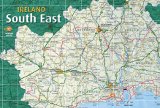South East Ireland Tourism
Travel guide to Ireland's south east
Travel guide to Ireland's south east
Norman History of Waterford
One of the most significant events in Norman Waterford and Ireland was the marriage of Strongbow and Aoife which took place in Christ Church Cathedral as it symbolised the long and sometimes tortuous birth of a new Ireland. In 1171 the King of England, Henry II, arrived in Waterford and anxious to exercise his control over a process of conquest that was taking place almost despite him, began to demand the submissions of the Anglo-Norman knights. The submission of Strongbow and his followers was received by Henry at Waterford. Henry II recognised Strongbow as McMurrough’s heir to Leinster but the strategically important port cities of Dublin and Waterford, which Strongbow had captured, were retained by the King. Henry II elevated Waterford to the status of a royal city - a status that was to change the course of the city’s history lace front wigs dramatically.
Consequently in the years after the invasion, many English and French merchants settled in Waterford. This new merchant class with its’ trading contacts in England and on the continent was to make Waterford medieval Ireland’s chief port for the import of wine and a major exporter of wool and hides. The city flourished during the 13th century and many new monasteries, friaries and churches were built. New stone-built defences protected its’ citizens and a sophisticated form of local government developed whereby the citizens elected a mayor on an annual basis to rule over the city.
The 14th century saw the beginning of the breakdown of Anglo-Norman power in Ireland. However Waterford’s close connections with cities such as Bristol and Chester ensured that it remained very much part of the English political scene. This century also saw the plague known as the ’Black Death’ wipe out a third of the city’s population. This decline in population, which was experienced all over Europe, had an adverse effect on trade. The subsequent decline in demand caused the City Fathers to become even more tenacious in protecting the city’s monopoly on shipping entering Waterford Harbour.
Traditionally, all ships entering the harbour, with the exception of those originating in Leinster, were obliged to unload at Waterford. In 1372 Waterford City Council commissioned the decoration of the Great Charter Roll, an illuminated manuscript measuring 14 feet in length, in an attempt to strengthen their legal case against the burgesses of New Ross who were working to nullify Waterford’s monopoly. The manuscript thus produced has fortunately been preserved in Waterford and is regarded as the most important Irish illuminated manuscript from the late medieval period and can be seen in the Waterford Museum of Treasures.
During the 14th and 15th centuries, Waterford was surrounded by hostile neighbours — the O’Driscolls, sea pirates from Co. Cork, who were the scourge of the city’s shipping, while their allies the Powers, an Anglo-Norman family who controlled County Waterford, were often known to attack the City and plunder the nearby countryside in search of booty. Yet despite the problems Waterford was by the end of the 15th century a strong and well-fortified city with an international reputation for good quality woollen shawls which were known on the continent as ’Waterford Rugs’.
In 1495 an attack on the city by Perkin Warbeck, a pretender to the throne of Henry VII was repulsed. Canon mounted on the ringworks in front of Reginald’s Tower saved the City and gave Waterford the distinction of being the first Irish city to use artillery in its defence. In recognition of the city’s loyalty, the King gave the city its’ own motto: ’Urbs Intacta Manet’ — Waterford, the Loyal City.
<< Return to Waterford History
Consequently in the years after the invasion, many English and French merchants settled in Waterford. This new merchant class with its’ trading contacts in England and on the continent was to make Waterford medieval Ireland’s chief port for the import of wine and a major exporter of wool and hides. The city flourished during the 13th century and many new monasteries, friaries and churches were built. New stone-built defences protected its’ citizens and a sophisticated form of local government developed whereby the citizens elected a mayor on an annual basis to rule over the city.
The 14th century saw the beginning of the breakdown of Anglo-Norman power in Ireland. However Waterford’s close connections with cities such as Bristol and Chester ensured that it remained very much part of the English political scene. This century also saw the plague known as the ’Black Death’ wipe out a third of the city’s population. This decline in population, which was experienced all over Europe, had an adverse effect on trade. The subsequent decline in demand caused the City Fathers to become even more tenacious in protecting the city’s monopoly on shipping entering Waterford Harbour.
Traditionally, all ships entering the harbour, with the exception of those originating in Leinster, were obliged to unload at Waterford. In 1372 Waterford City Council commissioned the decoration of the Great Charter Roll, an illuminated manuscript measuring 14 feet in length, in an attempt to strengthen their legal case against the burgesses of New Ross who were working to nullify Waterford’s monopoly. The manuscript thus produced has fortunately been preserved in Waterford and is regarded as the most important Irish illuminated manuscript from the late medieval period and can be seen in the Waterford Museum of Treasures.
During the 14th and 15th centuries, Waterford was surrounded by hostile neighbours — the O’Driscolls, sea pirates from Co. Cork, who were the scourge of the city’s shipping, while their allies the Powers, an Anglo-Norman family who controlled County Waterford, were often known to attack the City and plunder the nearby countryside in search of booty. Yet despite the problems Waterford was by the end of the 15th century a strong and well-fortified city with an international reputation for good quality woollen shawls which were known on the continent as ’Waterford Rugs’.
In 1495 an attack on the city by Perkin Warbeck, a pretender to the throne of Henry VII was repulsed. Canon mounted on the ringworks in front of Reginald’s Tower saved the City and gave Waterford the distinction of being the first Irish city to use artillery in its defence. In recognition of the city’s loyalty, the King gave the city its’ own motto: ’Urbs Intacta Manet’ — Waterford, the Loyal City.
<< Return to Waterford History






